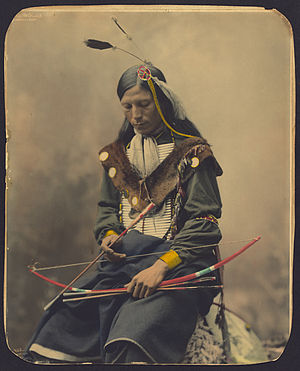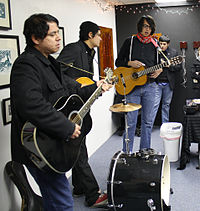- Oglala Lakota
-
Oglala Lakota Chief Bone Necklace (1899) Total population 42,357 enrolled tribal members (2008)[1] Regions with significant populations  United States (
United States ( South Dakota)
South Dakota)Languages Religion traditional tribal religion, Sun Dance,[3]
Native American Church, Christianity[4]Related ethnic groups other Lakota peoples, Dakota, Nakota[5]
The Oglala Lakota or Oglala Sioux (pronounced [oɡəˈlala], meaning "to scatter one's own" in Lakota language[5]) are one of the seven subtribes of the Lakota people; along with the Nakota and Dakota, they make up the Great Sioux Nation. A majority of the Oglala live on the Pine Ridge Indian Reservation in South Dakota, the eighth-largest Native American reservation in the United States. The Oglala are a federally recognized tribe whose official title is the Oglala Sioux Tribe of the Pine Ridge Reservation.
Contents
History
The Oglala Lakota, along with the six other groups of Lakota, had separated from each other by the early 19th century. By 1830, the Oglala had around 3,000 members. In the 1820s and 1830s, the Oglala, along with the Brulé, another Lakota band, and three other Sioux bands, formed the Sioux Alliance. This Alliance attacked surrounding tribes for territorial and hunting reasons.
Gender roles
Typically, in the Oglala Lakota society, the men are in charge of the politics of the tribe. The men were usually the chiefs for political affairs, war leaders and warriors, and hunters. Women are and always have been highly regarded and respected in the tribe. The Lakota are matrilineal and children belong to the mother's clan. Chiefs were selected based on the mother's clan. Women controlled the food, resources and movable property. When a man married, he went to live with his wife with her people. They could support her in childbearing and rearing and, if the couple separated, she would not be away from her people. This also helped control the men's behavior toward women. The women elders of the clan were highly respected and had to approve the selection of chiefs of the clans. If they withdrew their support, a man could not continue as chief. Both genders were equal in decisions and power.
Traditional culture
Family is of utmost importance to the Oglala Lakota, with loyalty to the tribe coming in close second. Each family had one or more tipi households. The women were critical to the family's life: they made almost everything the family and tribe used. They cultivated and processed a variety of crops; prepared the food; prepared game and fish caught by the men; worked skins to make clothing and footwear, as well as storage bags, the covering of tipis, and other items.
Beyond the family was the clan. Inheritance of clan chief positions and the composition of the clans was matrilineal: only the males born to the clan could be life chiefs of it. Within the clan, relatives whom Europeans and Americans would call cousins were considered, and identified by titles, equivalent to brothers and sisters. Because of the importance of the clan, a boy's maternal uncle, rather than his father, would often be the most influential male figure in his life. The uncle would integrate the boy into the clan's male society.
Bands
 Kevin Pourier is an Oglala Lakota jeweler and sculptor whose medium is buffalo horn.[6]
Kevin Pourier is an Oglala Lakota jeweler and sculptor whose medium is buffalo horn.[6]
Each of the twenty tribes were subdivided into bands (tiyospaye), which consisted of a number of smaller family camps (tiwahe). During parts of the year, the small camps were scattered across the region; at other times, these camps gathered together as a thiyóšpaye to cooperate on activities such as a large buffalo hunt. Each summer, usually in early June, bands from many groups gathered together for the annual sacred Sun Dance.
Writing in 1875, Dr. John J. Saville, the US Indian agent at the Red Cloud Agency, noted that the Oglala tribe was divided into three main bands: the Kiyuksa, the Oyuhpe and the head band or True Oglala. "Each of these bands are subdivided into smaller parties, variously named, usually designated by the name of their chief or leader."[7]
In the years immediately following the Fort Laramie Treaty of 1868, these bands became increasingly polarized as they and their leaders struggled with decisions relating to the continued American encroachment on their territory. Some bands chose to come in to the Indian agencies (forerunner to the reservations), where they received beef and other rations from the U.S. government. Other bands decided to remain out, attempting to continue the traditional lifeways for as long as possible. Many bands moved between these two extremes, coming in to the agencies during the winter and joining their relatives in the north each spring. These challenges further split the various Oglala bands.
Just prior to confinement on the reservations, the Oglala bands included:
Oyúȟpe Thiyóšpaye
- True Oyúȟpe (Big Road's band). Other members include: Black Elk
- Wakȟáŋ
- Makȟáiču (Red Dog's band)
Oglála Thiyóšpaye
- Čhaŋkȟahuȟaŋ (He Dog's band). Other members include: Short Bull; Amos Bad Heart Bull.
- Hokayuta (Black Twin's band)
- Húŋkpathila (Little Hawk and Crazy Horse's band)
- Itéšiča (Red Cloud's band)
- Payabya (Young Man Afraid of His Horses's band)
- Waglúȟe (Blue Horse, American Horse and Three Bear's bands)
Khiyáksa Thiyóšpaye
- Kuinyan (Little Wound's band)
- Tȟaphíšleča (Yellow Bear's band)
On the reservation
After being moved several times during the 1870s after the Great Sioux Reservation was broken up into five portions, the Red Cloud Agency was relocated in 1878 and renamed the Pine Ridge Reservation. By 1890, the reservation included 5,537 people, divided into a number of districts that include some 30 distinct communities.
The Rosebud Indian Reservation also includes enrolled Oglala Lakota members.
Oglala flag
First used in 1961, this flag was approved by the Oglala Sioux Triba OST Council on March 9, 1962 as the official flag of the Oglala Sioux Tribe (OST).
The circle of eight teepees on the flag represent the nine districts of the reservation: Porcupine, Wakpamni, Medicine Root, Pass Creek, Eagle Nest, White Clay, LaCreek, Wounded Knee, and Pine Ridge. The red field represents the blood shed by the tribe in defense of their lands and an allegorical reference to the term "red man," by which they were referred to by European Americans. The blue represents the sky, as seen in all four cardinal directions during the worship of the Great Spirit, and the elements. It also represents the Lakota spiritual concept of heaven or “the happy hunting ground" to which departed tribal members go.[8]
Notable Oglala leaders
- Crazy Horse
- Red Cloud
- Red Fish
- Little Wound
- Young Man Afraid Of His Horses
- American Horse (Wasechun-tashunka)
- Crow Dog (Kangisanka)
- Old Chief Smoke (Šóta)
- Cecilia Fire Thunder
- Theresa Two Bulls
See also
- Sičháŋǧu, Brulé (Burned Thighs)
- Itázipčho, Sans Arc (No Bows)
- Húŋkpapȟa
- Mnikȟówožu, Miniconjou
- Sihásapa, Blackfoot Sioux
- Oóhenuŋpa, Two Kettles
Notes
- ^ "Oglala Sioux Tribe Pine Ridge Reservation." Page 4 (retrieved 1 Sep 2010)
- ^ Pritzker 329K
- ^ Pritzker 331
- ^ Pritzker 335
- ^ a b Pritzker 328
- ^ Crash, Tom. "Oglala Lakota College opens their summer artist series ". Lakota Times. 12 June 2008 (retrieved 21 Dec 2009)
- ^ Saville to Commissioner of Indian Affairs, Aug. 31, 1875, published in Annual Report of the Commissioner of Indian Affairs (Washington, D.C.: Government Printing Office, 1875), p. 250. Dr. Saville listed four bands in his report. But, the Wajaje, while closely associated with the Oglala, considered themselves to be Brulé.
- ^ Oglala Sioux Tribe, Official Website
References
- Oglala Sioux Tribe: A Profile
- Pritzker, Barry M. A Native American Encyclopedia: History, Culture, and Peoples. Oxford: Oxford University Press, 2000. ISBN 978-0195138771.
Further reading
- Ruling Pine Ridge: Oglala Lakota Politics from the IRA to Wounded Knee Texas Tech University Press
- Black Elk Speaks: Being the Life Story of a Holy Man of the Oglala Sioux University of Nebraska Press
External links
- Oglala Sioux Tribe, official website
Native Americans in Nebraska Tribes Reservations Former reservations Figures Antonine Barada · Big Elk · Chief Blackbird · Joba Chamberlain · Larry EchoHawk · Logan Fontenelle · Francis La Flesche · Joseph La Flesche · Old Lady Grieves The Enemy · Petalesharo · Susan La Flesche Picotte · Red Cloud · Standing Bear · Susette LaFlesche Tibbles · Jim Thorpe · James Young Deer · Moses J. "Chief" Yellow HorsePlaces Blackbird Hill · Nanza · Genoa Indian Industrial School · Ton'wontongathon · Pahur · Ahkawitakol · Lalawakohtito · Pahuk · Pike-Pawnee Village SiteLanguages Events Battle of Ash Hollow · Massacre Canyon · Battle of War Bonnet Creek · Grattan massacre · Cheyenne WarCategories:- Lakota
- Native American tribes in South Dakota
- Federally recognized tribes in the United States
Wikimedia Foundation. 2010.



